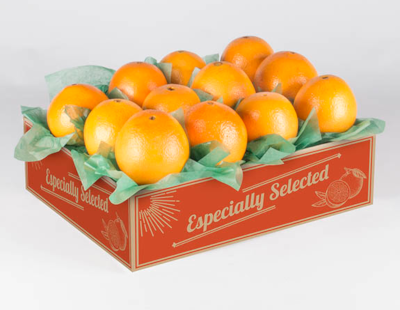
| Fast Facts | |
|---|---|
| Availability | Nov 7 to May 20 |
| Status | Avail. Next Season |
| Shipped to | US* & Canada** |
| *excluding AK, HI **excluding T, V, X, Y codes | |
Navel Oranges
Navel Oranges are the juicy, sweet, seedless, easy–peeling oranges you know and love from your childhood. If you're searching for the "classic" orange for fresh eating enjoyed for generations as a holiday gift, look no further. There is simply no better orange for eating out of hand.
We ship Florida Navels November to late–January, and California Navels late–January through May.
Navels make a perfect gift for Thanksgiving, Hannukah, Christmas and New Year. Like all our citrus, these delicious treats are high in vitamin C and great for your health.
Navel Orange Juice
Squeezing up some fresh juice? Navels are a great choice! There's nothing as refreshing as fresh-squeezed OJ.... it really tastes nothing like the kind you get in a carton or reconstitute from a can. Because several oranges go into a glass of juice, it's also a concentrated source of vitamin C and healthful antioxidants, and provides a good dose of magnesium, potassium, and folate. Due to the unique properties of navel orange juice, however, it should be consumed within a few hours of squeezing for best quality. So, make sure you enjoy this special treat soon after you squeeze it — not that this is likely to be a problem.

Availability
Navel Oranges are available November to May.
History
What with the incredible popularity, great taste, and convenient seedlessness of the navel, you might wonder if it's a recently "invented" fruit bred by scientists or experts in search of the perfect orange. The navel is actually quite an old variety. Researchers believe it dates back to a single-branch mutation, also called a "bud sport," originally found on a Selecta orange tree in the garden of a monastery near Bahia, Brazil. These first navels were discovered way back around 1810-1820, when they were noticed right away for their sweet, seedless flesh and for that unique "navel" or "belly button" at the end of the fruit. (The "navel," part of the mutation, is actually a tiny second orange—a conjoined twin, if you will!)
From there, the navel orange is believed to have been introduced to Florida by an unknown planter in 1835, back before the territory was even a state. However, it's generally thought that these groves were burned to the ground during the second Seminole War, when the United States government was attempting to force Florida's original inhabitants, the Seminole Indians, out of Florida. In the chaos and destruction of war, many believe this variety was lost to our area for the time being. Yet an interesting letter published in the New York Times in 1902 also claims that the navel was being grown commercially near Palatka, FL in the early 1870s. If true, this means the navel got "off the ground" in Florida before doing so in California—as story described below.
In 1870, twelve cuttings from the original Brazilian tree were sent to the USDA in Washington. From there, a few made their way out to an interesting woman in California named Eliza Tibbets. Tibbets, who in her time was a suffragist, a spiritualist, and an activist working to help freed former slaves, nurtured the young trees along on dishwater and hope, believing the fruit would one day strike it big, until the navel was "discovered" at agricultural fairs for its many appealing qualities. There soon followed a navel orange "boom" that spread back to Florida and continues to this day. In fact, the amazing growth of the California citrus industry following the introduction of the navel orange is sometimes referred to as California's "second gold rush."
Believe it or not, one of the original 12 trees brought to California is still alive and producing fruit in Riverside California today proving just how long a citrus tree can live. It's been designated a historic landmark by the state of California. There are other historic fruit trees like this in existence, including the so-called "Mother Orange Tree" of California (still producing fruit and dating from 1856) and even a bitter orange tree in Versailles, France that is said to date to the 1400s. Though citrus trees may not grow particularly tall, never underestimate their ability to hang onto life and continue to produce the golden fruit cherished around the world!
But wait. Remember how we said that the navel is seedless? So...where do all these navel trees come from? How do they reproduce? This brings us to an important and amazing point about navel orange trees around the world. Since they can't be grown from seed, every single one of the millions of navel orange trees in existence is a graft. What do we mean by graft? To graft a navel orange tree, a cutting is taken from a tree already in existence and joined carefully onto what's called a "rootstock" of another type of tree, applying adhesive to keep the branches together. (This process was invented over 4000 years ago, and it's not just done for navels, but many types of citrus.) This creates a new navel orange tree—but amazingly, every Washington navel tree out there is essentially a "clone" of that very first navel tree found and cherished for its unique qualities in Brazil, some 200 years ago!
Nutritional Information for Florida Navel Oranges
One navel orange, approx. 3" in diameter, contains:
- 1 g protein
- 11.6 g carbohydrates
- 2.4 g dietary fiber
- 65 mg calcium
- 283 mg potassium
- 26 mg phosphorus
- 340 IU vitamin A
- 105 mg vitamin C
- 86% water
Navel Oranges Product Specifications
Package Particulars
Recommended for: 1 person
Orange-Grapefruit-Mixed?: Specify mixed to
include Ruby Red Grapefruit
Weight (approx.): 3.6 lb/16 kg
Pieces (approx.): 6 oranges -OR-
3 oranges, 2 grapefruit
Available to: U.S. and Canada
Package Particulars
Recommended for: 1-2 persons
Orange-Grapefruit-Mixed?: Specify mixed to
include Ruby Red Grapefruit
Weight (approx.): 8.2 lb/3.7 kg
Pieces (approx.): 12 oranges -OR-
6-8 oranges, 4 grapefruit
Available to: U.S. and Canada
Package Particulars
Recommended for: 2-3 persons
Orange-Grapefruit-Mixed?: Specify mixed to
include Ruby Red Grapefruit
Weight (approx.): 15.6 lb/7 kg
Pieces (approx.): 24 oranges -OR-
14 oranges, 6 grapefruit
Available to: U.S. and Canada
Package Particulars
Recommended for: 3-4 persons
Orange-Grapefruit-Mixed?: Specify mixed to
include Ruby Red Grapefruit
Weight (approx.): 23.3 lb/10.5 kg
Pieces (approx.): 36 oranges -OR-
21 oranges, 9 grapefruit
Available to: U.S. and Canada
Package Particulars
Recommended for: 4-6 persons
Orange-Grapefruit-Mixed?: Specify mixed to
include Ruby Red Grapefruit
Weight (approx.): 36 lb/16.3 kg
Pieces (approx.): 48-60 oranges -OR-
32 oranges, 16 grapefruit
Available to: U.S. and Canada
Florida Fruit Shippers® is a registered trademark of Vegetable Kingdom Inc.